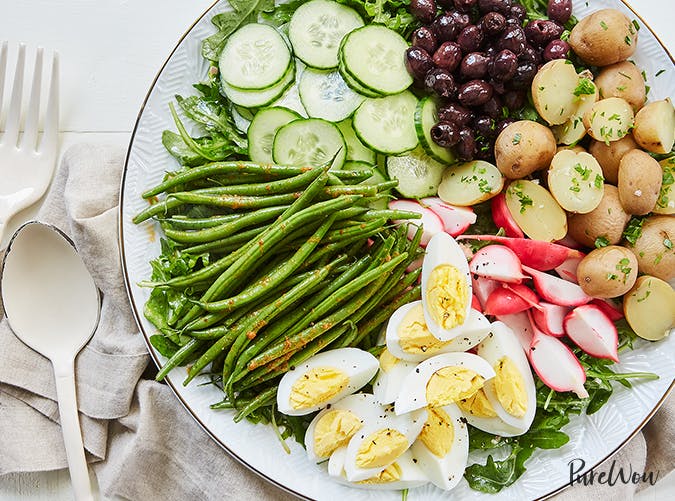‘Eat food. Not too much. Mostly plants’, are famous worlds spoken by American academic Michael Pollan, and they are taking the world by storm, one newly converted vegetarian at a time.
Indeed, there are many compelling reasons for shifting towards a vegetarian or vegan lifestyle, including reduced risk of chronic disease, affordability, social conscience, and environmental sustainability. However, going vegetarian can have consequences for your health, if you start replacing proteins with large carbohydrate portions, even ‘good’ carbs! As we all know, large servings of bread, pasta and rice are not the best for your waistline! Not to mention – there IS such a thing as too many healthy fats – sigh 🙁
On that note – here are our 5 recommendations for managing your weight on a plant-based diet:
- Control your portion sizes of carbohydrate foods.
Plant based diets, in particular, rely on good quality carbohydrates. Including low GI carbohydrates will help to stabilise your blood sugar levels, boost your focus, and keep you fuller between meals. High fibre options can also reduce cholesterol and support gut health.
Just to be clear, carbs are NOT the devil. But, they are a source of fuel, or ‘energy’. Many plant-based eaters fall into the trap of eating carb-heavy meals, lacking in protein and vegetables. This can leave you feeling sluggish, and can lead to weight gain.Consider your portion sizes at each meal. We suggest 1-2 slices of wholegrain bread, ½ cup of wholegrains (i.e. oats, quinoa, basmati rice, barley), 1 cup of wholemeal or pulse pasta, and 1 cup of starchy vegetables (i.e. potato, sweet potato, corn, legumes).
- Try not to double up on your carbohydrate portions.
Legumes are a staple protein and iron source for many vegetarians, however, they are also a ‘carbohydrate’ portion. So, if you team them up with large portions of rice, pasta, bread or wraps, the carbohydrate content of your meal will skyrocket – and we all know where excess carbs get stored!When using legumes, try replacing half of the above suggested carb portions with vegetables. For example – when making a lentil bolognese, use half pasta and half zucchini noodle. When making a buddah bowl or naked burrito, use half rice and half cauliflower rice. When maxing tacos, fill one medium tortilla with legumes and salad, then tuck into the remaining salads to fill you up.
Alternatively, choose a low-carb protein. We recommend the above serving suggestions for carbohydrates with tofu, tempeh, eggs, or low fat dairy.
- Know which fruits and vegetables are lower in sugar/carbohydrate.
This is a point of confusion for many people, so we have listed the vegetables and fruits with the lowest and highest amount of sugars. Make sure you keep low-sugar fruits and low-carb veggies in your fridge or freezer at all times, and limit your portion sizes of higher-sugar varieties.Low Carb Vegetables (4 serves per day): Asian greens, asparagus, green beans, bean sprouts, broccoli, Brussel sprouts, cabbages, capsicums, carrots, cauliflower, celery, cucumber, eggplant, fennel, green leafy vegetables (chard, kale, lettuce, rocket, silverbeet, spinach), leek, mushrooms, onions, radishes, snow peas, tomatoes, turnips, zucchini
Low Sugar Fruits (1-2 serves per day): Avocadoes, berries (all kinds), cherries, citrus fruits (i.e. grapefruit, lemon, lime, mandarin), kiwi, passionfruit
Higher Carb Veggies (1 serve per day): corn, legumes (lentils, chickpeas, beans), potato, sweet potato, taro
Higher Sugar Fruits (1 serve per day): Banana, dates, dried fruits, grapes, mango, tinned fruits, watermelon
- Know your healthy fat portions
Once upon a time, a ‘low fat’ diet was recommended for weight loss. Times have changed. Now, we respect the role dietary fats in transporting fat-soluble vitamins and antioxidants, and keeping us full between meals. Unsaturated fats, in particular, protect heart health. However, fat is the most energy-dense nutrient, offering double the number of calories per gram than carbohydrates and proteins. So, large portions throughout the day may contribute to weight gain.We suggest stick with 5 servings of healthy fats per day, for weight management. One serve is 1/4 avocado, 30g nuts or seeds, 1 dessert spoon of olive oil, 1 dessert spoon of nut paste, 1/4 cup coconut milk/yoghurt. Be mindful of your cheese portions as well!
- Write a menu plan for the week, and keep your fridge and freezer stocked.
To avoid running out of ingredients to prepare balanced vegetarian meals, create a menu plan for the week. Make sure you buy enough low-carb vegetables and vegetarian proteins, in particular. We also suggest buying frozen veggies for your freezer, in case of emergency. If you’re super organised, start your week on a good note by preparing bulk vegetarian meals over the weekend – think soups, dahls, tofu and lentil burgers, roast veggies, curries and frittatas. You don’t want to be stuck ordering a pizza or preparing microwave mac-and-cheese!



